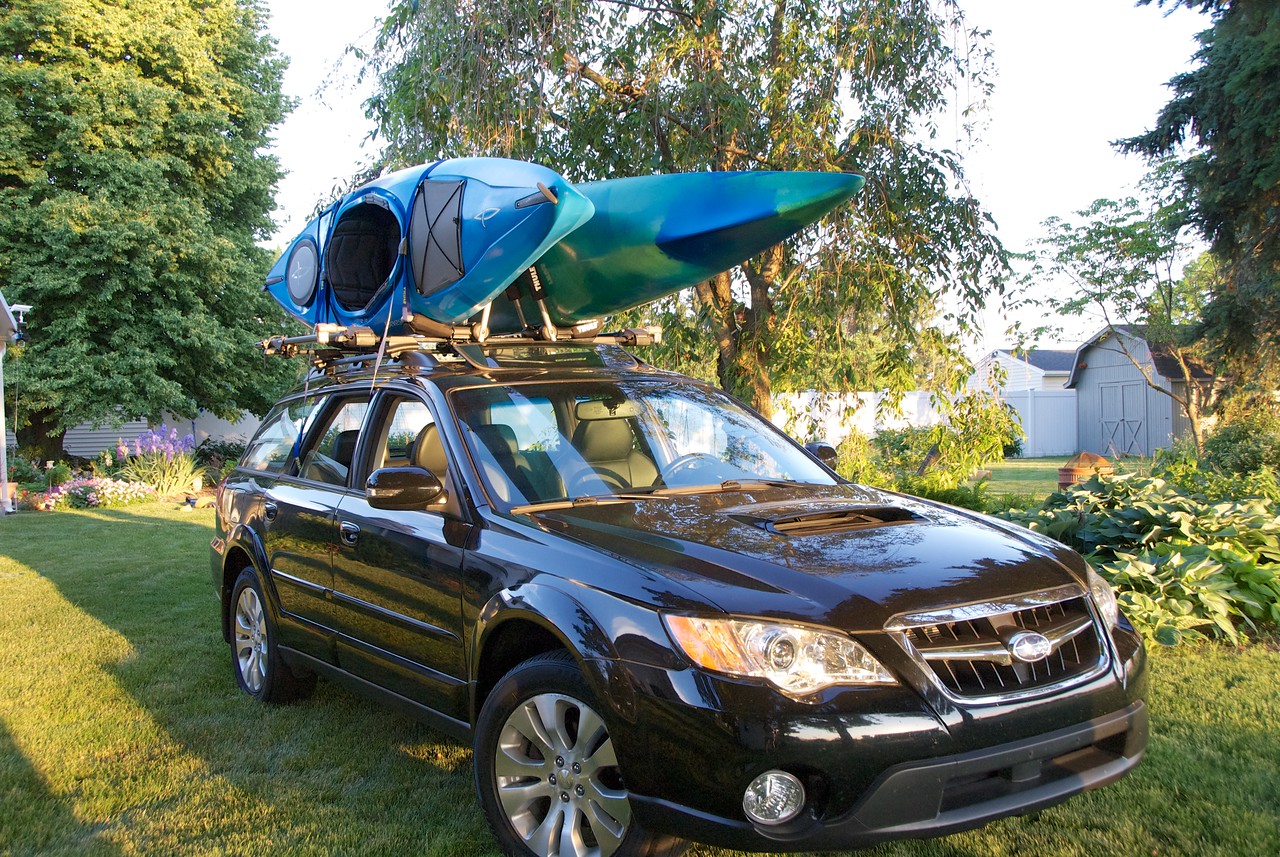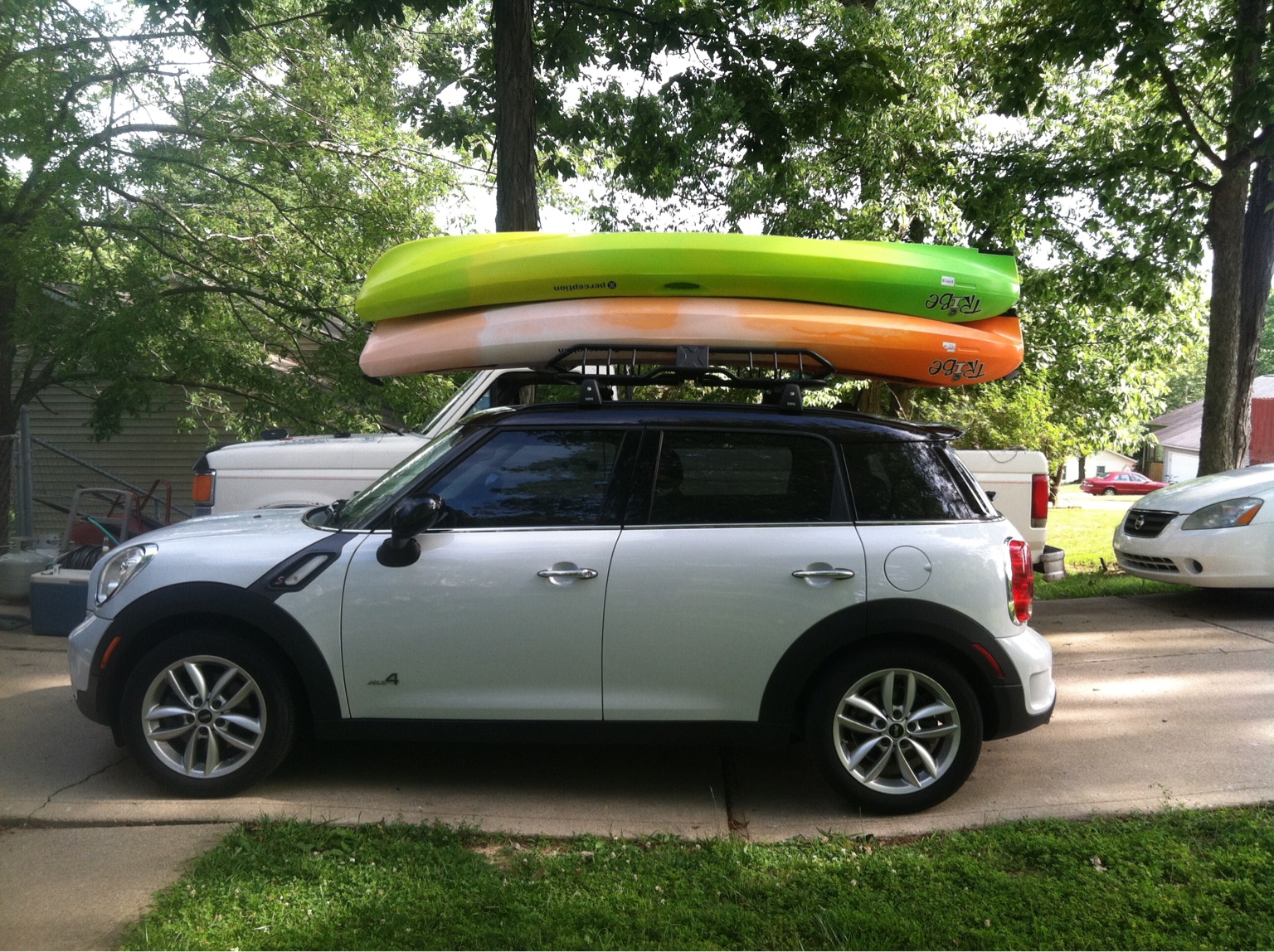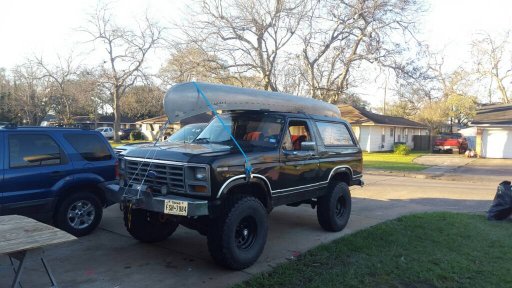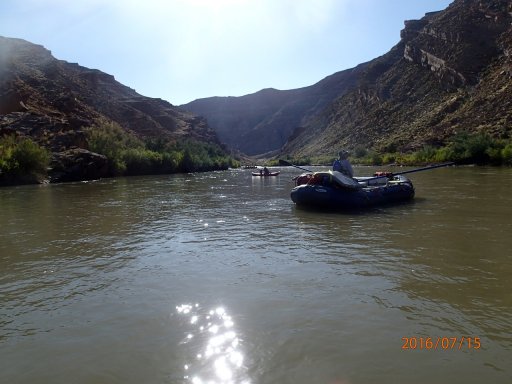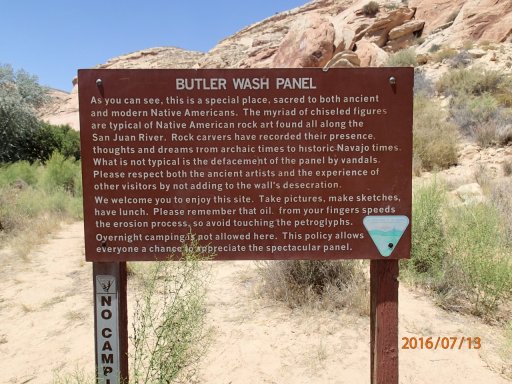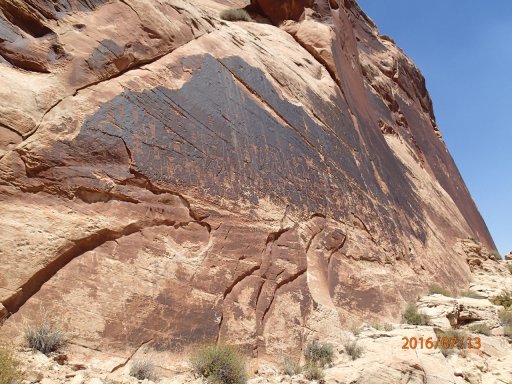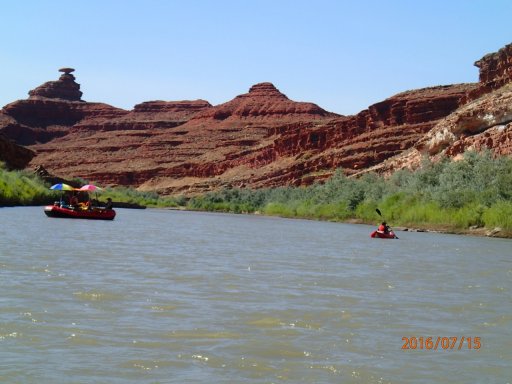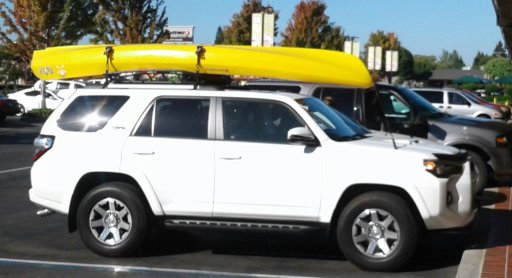Overlanding with a Kayak

Headed out on a kayak camping trip, My Overlanding Buddy Justin is sporting a custom made wood paddle, its light, sleek, cool looking and made to his specifications. He is wearing a Stohlquist PFD.
Ovelanding is a gateway to adventure. To some its about the exciting combination of vehicle, journey, and destination. But for others, the destination has more than a singular promise of discovery. Trekking, Biking or Kayaking are excellent extensions to Overlanding and can be quite the adventure all by themselves. But when you combine them with the capabilities and range of the Overland vehicle mothership, things get really interesting really fast. By providing transportation and relative comfort, your Overland vehicle is pretty much the ultimate base camp. What would normally be an arduous or even impossible environment to access by yourself, now becomes fun and part of the overall experience.
In this installment I will focus on Kayaks. A misunderstood sometimes misrepresented and often misused boat. Kayaks are fun and offer great exercise, with the right clothing and equipment, they can be used in any weather any time. They provide excellent platforms for fishing, photography and basic exploration. They generally require little water to navigate safely and can be pushed hard or taken leisurely. Some can even carry up to 500lbs, thats a 1/4 of a ton in a boat that might weigh less than 60.lbs and cruise at 4knots. Like everything else, there are general purpose boats and there are specialized boats. It is important to get the right boat for your target activity, but even more important and often overlooked is the associated equipment.
Buying a white water boat for fishing and then going super cheap on way too big a paddle is the automotive equivalent of buying a TRDPro 4Runner, lowering the suspension and fitting 26inch low profile wheels and tires on it. Sure it will still drive, but you wont get the best performance out of it and you sure aren't taking advantage of its intended design specialty. The same can be said about the paddle. Its better to have a less capable boat and a really good paddle than the other way around. Think of it like this, Paddles are like your tires, and the boat is your vehicle. The Kayak paddle is how you gain traction on the water, its a major player in the boat’s maneuverability, speed and will determine how tired you are (no pun intended) at the end of a paddle session.
Just like we have Mud, Snow, Sand tires. There are specific paddles for most boat and water types. But just like there is an all terrain tire, there are paddles designed for multiple uses and water types. Another often overlooked component is the personal flotation device, otherwise known as a PFD. You don't drive without a seatbelt, why would you paddle without a PFD? A properly fitted PFD will be comfortable and wont restrict your movement. Actually, some are really comfortable. Don't be cheap, when you go get that really good paddle, don't forget the really good PFD. As a mater of fact, I recommend buying the paddle and PFD first and then getting the boat. That way, you wont go over your budget, and you wont have any excuses.
Both Paddles and PFD’s come in more than one size and need to be selected appropriately for optimal fit and performance.

Day 3 of a 4 day 110 mile unsupported paddle around the Land Between the Lakes national park Kentucky. The boat is a 17 foot Necky Looksha Touring boat. The Paddle is a Warner Camano carbon fiber 253cm touring paddle. The PFD is a Stohlquist unit. Out back, there's a swift carbon touring paddle as the spare tire uhum, I mean spare paddle.
Chose your boat wisely, there are 4 major categories of boats. Touring, Recreational, white water and hybrids. All boats can be organized under these main categories.
Touring Boats are the Overlanding boats of the kayak world, sleek long fast and capable of carrying large loads. Designed for paddling in open water, some are used to traverse oceans during transcontinental trips. These boats are capable of self supported extended trips. Normally 17 to 20 feet in length, hard to transport and store, but lots of fun. Not easy to paddle, they are expensive and are the play things of advanced paddlers. Less capable, shorter 10 to 14 foot options are also available. Normally touring boats will be fitted with a skeg or a rudder.
Recreational boats are the car equivalent of a regular pick up or a sport utility vehicle. The largest category, most common boats fall into this group. These are your stable slow moving boats, they are best suited to calm bodies of water and rivers. Recreational boats are normally short and wide, with wide deck openings and lots of cockpit space. They are great for putting around. With the exception of fishing boats, they are generally inexpensive when compared to other specialty kayaks.
White water boats are the automotive equivalent of a Baja trophy truck. They are short wide and extremely maneuverable. They have little room for anything other than survival and recovery equipment. They are fitted to the paddler and are a blast to paddle if you know what you are doing. If you don't know what you are doing they are terrifying. They are best suited to fast moving bodies of water. These boats are at home in angry boiling torrents. Hard to paddle in a straight line, they are made for correcting direction rather than selecting a direction. Really good for short burst but terrible and taxing to paddle in calm wide bodies of water.
Hybrids are a new kind of boat, and they are awesome. Designed to handle a little bit of everything they are the jacks of all trades, master of none. With the exception of large open bodies of water, this boat will put a smile on your face. They are basically a longer type of white water boat called a creek boat. These boats got fitted with skegs to enable them to go in a straight line over calm water. They were also fitted with bulkheads and access ports enabling them to store enough gear and supplies for a day or three. Excellent day boats. Hybrids are a cross between a touring boat and a whitewater boat. The cockpit is not exactly spacious but its not as tight as in a white water boat. They are not cheap, but they are worth every penny. If you can only have one boat, this is it.

Headed out on a kayak camping trip, My Overlanding Buddy Justin is sporting a custom made wood paddle, its light, sleek, cool looking and made to his specifications. He is wearing a Stohlquist PFD.
Ovelanding is a gateway to adventure. To some its about the exciting combination of vehicle, journey, and destination. But for others, the destination has more than a singular promise of discovery. Trekking, Biking or Kayaking are excellent extensions to Overlanding and can be quite the adventure all by themselves. But when you combine them with the capabilities and range of the Overland vehicle mothership, things get really interesting really fast. By providing transportation and relative comfort, your Overland vehicle is pretty much the ultimate base camp. What would normally be an arduous or even impossible environment to access by yourself, now becomes fun and part of the overall experience.
In this installment I will focus on Kayaks. A misunderstood sometimes misrepresented and often misused boat. Kayaks are fun and offer great exercise, with the right clothing and equipment, they can be used in any weather any time. They provide excellent platforms for fishing, photography and basic exploration. They generally require little water to navigate safely and can be pushed hard or taken leisurely. Some can even carry up to 500lbs, thats a 1/4 of a ton in a boat that might weigh less than 60.lbs and cruise at 4knots. Like everything else, there are general purpose boats and there are specialized boats. It is important to get the right boat for your target activity, but even more important and often overlooked is the associated equipment.
Buying a white water boat for fishing and then going super cheap on way too big a paddle is the automotive equivalent of buying a TRDPro 4Runner, lowering the suspension and fitting 26inch low profile wheels and tires on it. Sure it will still drive, but you wont get the best performance out of it and you sure aren't taking advantage of its intended design specialty. The same can be said about the paddle. Its better to have a less capable boat and a really good paddle than the other way around. Think of it like this, Paddles are like your tires, and the boat is your vehicle. The Kayak paddle is how you gain traction on the water, its a major player in the boat’s maneuverability, speed and will determine how tired you are (no pun intended) at the end of a paddle session.
Just like we have Mud, Snow, Sand tires. There are specific paddles for most boat and water types. But just like there is an all terrain tire, there are paddles designed for multiple uses and water types. Another often overlooked component is the personal flotation device, otherwise known as a PFD. You don't drive without a seatbelt, why would you paddle without a PFD? A properly fitted PFD will be comfortable and wont restrict your movement. Actually, some are really comfortable. Don't be cheap, when you go get that really good paddle, don't forget the really good PFD. As a mater of fact, I recommend buying the paddle and PFD first and then getting the boat. That way, you wont go over your budget, and you wont have any excuses.
Both Paddles and PFD’s come in more than one size and need to be selected appropriately for optimal fit and performance.

Day 3 of a 4 day 110 mile unsupported paddle around the Land Between the Lakes national park Kentucky. The boat is a 17 foot Necky Looksha Touring boat. The Paddle is a Warner Camano carbon fiber 253cm touring paddle. The PFD is a Stohlquist unit. Out back, there's a swift carbon touring paddle as the spare tire uhum, I mean spare paddle.
Chose your boat wisely, there are 4 major categories of boats. Touring, Recreational, white water and hybrids. All boats can be organized under these main categories.
Touring Boats are the Overlanding boats of the kayak world, sleek long fast and capable of carrying large loads. Designed for paddling in open water, some are used to traverse oceans during transcontinental trips. These boats are capable of self supported extended trips. Normally 17 to 20 feet in length, hard to transport and store, but lots of fun. Not easy to paddle, they are expensive and are the play things of advanced paddlers. Less capable, shorter 10 to 14 foot options are also available. Normally touring boats will be fitted with a skeg or a rudder.
Recreational boats are the car equivalent of a regular pick up or a sport utility vehicle. The largest category, most common boats fall into this group. These are your stable slow moving boats, they are best suited to calm bodies of water and rivers. Recreational boats are normally short and wide, with wide deck openings and lots of cockpit space. They are great for putting around. With the exception of fishing boats, they are generally inexpensive when compared to other specialty kayaks.
White water boats are the automotive equivalent of a Baja trophy truck. They are short wide and extremely maneuverable. They have little room for anything other than survival and recovery equipment. They are fitted to the paddler and are a blast to paddle if you know what you are doing. If you don't know what you are doing they are terrifying. They are best suited to fast moving bodies of water. These boats are at home in angry boiling torrents. Hard to paddle in a straight line, they are made for correcting direction rather than selecting a direction. Really good for short burst but terrible and taxing to paddle in calm wide bodies of water.
Hybrids are a new kind of boat, and they are awesome. Designed to handle a little bit of everything they are the jacks of all trades, master of none. With the exception of large open bodies of water, this boat will put a smile on your face. They are basically a longer type of white water boat called a creek boat. These boats got fitted with skegs to enable them to go in a straight line over calm water. They were also fitted with bulkheads and access ports enabling them to store enough gear and supplies for a day or three. Excellent day boats. Hybrids are a cross between a touring boat and a whitewater boat. The cockpit is not exactly spacious but its not as tight as in a white water boat. They are not cheap, but they are worth every penny. If you can only have one boat, this is it.
Last edited:





